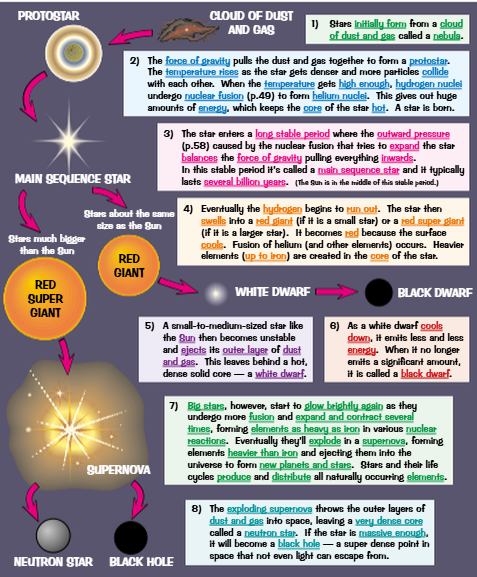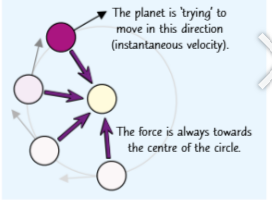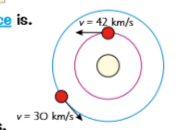Topic 8 - Space physics
1/13
There's no tags or description
Looks like no tags are added yet.
Name | Mastery | Learn | Test | Matching | Spaced |
|---|
No study sessions yet.
14 Terms
What do stars initially form from? What’s a protostar & how is a star born? Whats a main sequence star?
Stars initially form from a cloud of dust and gas called a nebula.
The force of gravity pulls the dust and gas together to form a protostar. The temperature rises as the star gets denser and more particles collide with each other. When the temperature gets high enough, hydrogen nuclei undergo nuclear fusion to form helium nuclei. This gives out huge amounts of energy, which keeps the core of the star hot. A star is born.
The star enters a long stable period where the outward pressure caused by the nuclear fusion that tries to expand the star balances the force of gravity pulling everything inwards.
In this stable period it's called a main sequence star and it typically lasts several billion years. (The Sun is in the middle of this stable period.)
What happens to a main sequence star after? Hows a white dwarf formed? Hows a black dwarf formed?
Eventually the hydrogen begins to run out. The star then swells into a red giant (if it is a small star) or a red super giant (if it is a larger star). It becomes red because the surface cools. Fusion of helium (and other elements) occurs. Heavier elements (up to iron) are created in the core of the star.
A small-to-medium-sized star like the Sun then becomes unstable and ejects its outer layer of dust and gas. This leaves behind a hot, dense solid core - a white dwarf.
As a white dwarf cools down, it emits less and less energy. When it no longer emits a significant amount, it is called a black dwarf.
How is a supernova formed and what happens after it?Hows a neutron star formed? hows a black hole formed?
Big stars, however, start to glow brightly again as they undergo more fusion and expand and contract several times, forming elements as heavy as iron in various nuclear reactions. Eventually they'll explode in a supernova, forming elements heavier than iron and ejecting them into the universe to form new planets and stars. Stars and their life cycles produce and distribute all naturally occurring elements.
The exploding supernova throws the outer layers of dust and gas into space, leaving a very dense core called a neutron star. If the star is massive enough, it will become a black hole - a super dense point in space that not even light can escape from.

Whats out solar system? What do planets do? What do Dwarf planets do?
The solar system is all the stuff that orbits our Sun. This includes things like:
Planets - these are large objects that orbit a star. There are eight in our solar system. They have to be large enough to have "cleared their neighbourhoods". This means that their gravity is strong enough to have pulled in any nearby objects apart from their natural satellites.
Dwarf planets, like our pal Pluto. These are planet-like objects that orbit stars, but don't meet all of the rules for being a planet.
What do moons do? What do artificial satellites do? Whats our solar system part of & what is that?
Moons - these orbit planets. They're a type of natural satellite (i.e. they're not man-made).
Artificial satellites are satellites that humans have built. They generally orbit the Earth.
Our solar system is a tiny part of the Milky Way galaxy. This is a massive collection of billions of stars that are all held together by gravity.
The planets move around…? How is an object constantly accelerating? What does this also mean?
The planets move around the Sun in almost circular orbits (the same goes for the Moon orbiting the Earth).
If an object is travelling in a circle it is constantly changing direction, which means it is constantly accelerating. (Just like a car going around a roundabout,)
This also means it is constantly changing velocity (but NOT changing speed).
For an object to accelerate there must be? This force would cause the object to? The object keeps accelerating towards what its…? The force that makes this happen is provided by?
For an object to accelerate, there must be a force acting on it. This force is directed towards the centre of the circle.
This force would cause the object to just fall towards whatever it was orbiting, but as the object is already moving, it just causes it to change its direction.
The object keeps accelerating towards what it's orbiting but the instantaneous velocity (which is at a right angle to the acceleration) keeps it travelling in a circle.
The force that makes this happen is provided by the gravitational force (gravity) between the planet and the Sun (or between the planet and its satellites).

The closer you get to a star/planet? The stronger the force…? For an object in a stable orbit if the speed of the object changes…?
The closer you get to a star or planet, the stronger the gravitational force is.
The stronger the force, the faster the orbiting object needs to travel to remain in orbit (to not crash into the object that it's orbiting).
For an object in a stable orbit, if the speed of the object changes, the size (radius) of its orbit must do so too. Faster moving objects will move in a stable orbit with a smaller radius than slower moving ones.

Why does the universe look like its getting bigger? When we look at light from most distant galaxies…? What’s red-shift? What does this suggest?
As big as the universe already is, it looks like it's getting even bigger. All its galaxies seem to be moving away from each other. There's good evidence for this…
When we look at light from most distant galaxies, we find that the wavelength has increased.
The wavelengths are all longer than they should be - they're shifted towards the red end of the spectrum. This is called red-shift.
This suggests the source of the light is moving away from us. Measurements of the red-shift indicate that these distant galaxies are moving away from us (receding) very quickly - and it's the same result whichever direction you look in.
More distant galaxies have…? Whats the conclusion?
More distant galaxies have greater red-shifts than hearer ones. This means that more distant galaxies are moving away faster than hearer ones.
The inescapable conclusion appears to be that the whole universe (space itself) is expanding.
Give the example of how the universe seems to be expanding with a balloon?
Imagine a balloon covered with pompoms
As you blow into the balloon, it stretches.
The pompoms move further away from each other.
The balloon represents the universe and each pompom is a galaxy. As time goes on, space stretches and expands, moving the galaxies away from each other.
This is a simple model (balloons only stretch so far, and there would be galaxies 'inside' the balloon too) but it shows how the expansion of space makes it look like galaxies are moving away from us.
Give the theory of how the universe started (supported with theories)? Explain this theory (2)
So all the galaxies are moving away from each other at great speed - suggesting something must have got them going. That 'something' was probably a big explosion - the Big Bang. Here's the theory ...
Initially, all the matter in the universe occupied a very small space. This tiny space was very dense and so was very hot.
Then it 'exploded' - space started expanding, and the expansion is still going on.
Whats something to remember about the big bang theory? Theres still lots we dnt’t know about the universe…?
Something important to remember is that the Big Bang theory is the best guess we have so far. Whenever scientists discover new evidence, they have to either make a new theory or change a current one to explain what they've observed.
There is still lots we don't know about the universe. Observations of supernovae from 1998 to the present day appear to show that distant galaxies are moving away from us faster and faster (the speed at which they're receding is increasing).
What do scientists currently think the universe is mostly made up of?
Currently scientists think the universe is mostly made up of dark matter and dark energy. Dark matter is the name given to an unknown substance which holds galaxies together, but does hot emit any electromagnetic radiation. Dark energy is thought to be responsible for the accelerated expansion of the universe. But no-one really knows what these things are, so there are lots of different theories about it. These theories get tested over time and are either accepted or rejected.